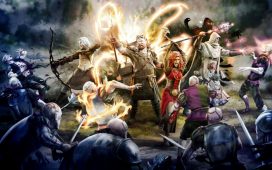Imagine for a moment you don’t know anything about Baldur’s Gate and Planescape: Torment. (And maybe you really don’t, they are 20 years old.) But you know they’re games and you know they’re old, and you probably know they’re RPGs. Beyond that, it’s scraps you’ve overhead in conversations. People saying “nothing comes close!” or “philosophical depth!” or “best RPG ever!”. They don’t talk mechanics, they talk themes. They talk about these games as if they were legends. Does it ever really occur to you what they’re like to nuts-and-bolts play?
These games arrive on console tomorrow (15th October) for the very first time – on PlayStation 4, Xbox one and Nintendo Switch – and that’s a pretty big deal. It’s true: these are classic RPGs. In Baldur’s Gate, you have an enormous adventure that takes you from fantasy hero right through to being a god over the course of two games, and in Planescape: Torment you have one of the most philosophically probing adventures I’ve ever played, set in one of the most bizarre worlds and supported by one of the most bizarre casts. And, oh my, what a twist.
Package all that up and it’s a very enticing proposition, particularly as you get more than one game for your money (they are full-price, 40 packages). There are a few permutations of what you can buy. There’s a Baldur’s Gate pack, which bundles the two Baldur’s Gate games plus their expansions – including the recently made Siege of Dragonspear. There’s a Planescape: Torment and Icewind Dale double-pack, which includes expansions, and there’s Neverwinter Nights pack coming 3rd December, which includes expansions as well as the best of the community-made campaigns.
I tried the BG and PST packs on Nintendo Switch, and they’re fine. I didn’t notice any load times and the characters moved around the areas quickly and fluidly. Capable radial menus make sense of the enormous amount of tinkering there is to do in a game like this – rifling through bags, looking-up character sheets, swapping equipment, changing spells, etc. More importantly, for a game based so heavily on reading, there are quality of life improvements such as being able to increase the size of the text. At maximum size, it’s readable on Nintendo Switch in handheld mode – the ultimate test. It’s playable, in other words – it works.
But it’s clear these games were never designed with consoles in mind. They are frustrating to play on a pad. I have lost count of the amount of times I’ve ended up accidentally triggering map zoom-out instead of the command I wanted. Between shoulder-buttoning through characters, trigger-pressing for radial menus, hitting X to enable hotbars and then individually select abilities, my brain was tied in a knot. It got easier with muscle memory but never comfortable, never intuitive.
On top of that, it’s hard to see what’s going on. I’m romantic about the old look and feel of the games, and the stuttery animation – I get a warm feeling in my heart to see it – but there’s no getting away from the lack of clarity, particularly when the environments are darker and muddier in colour. And on the smaller Switch screen, the problem is exacerbated.
This isn’t the fault of Skybound games or Beamdog. They have done everything they possibly can to polish these games up – given them all the surgery they can take. The problem is deeper, fundamental: these are old PC games. Mechanically, they creak, and they’re out of their element. Frankly, they’re not fun to play.
RPGs have improved so much in 20 years (hold your anger, I’ll return to this). Underneath every new adventure is years of accrued learning. They have, in other words, progressed. That’s not to say you can’t enjoy older games – far from it. I love endlessly rerolling character stats (I genuinely do) and I love how unapologetically nerdy RPGs were when they weren’t trying to broaden their appeal. But there’s an inherent awkwardness to playing them now.
I bet you’re fuming. How dare I suggest they’re not very good – they’re still a hundred times better than a hundred games these days. I’m half with you – I love those old games. But what I think you mean is the story and setting and characters are a hundred times better – the aspects which transcend the creaky old shells they’re encased in. The aspects which become legendary in the retelling.
To me, it’s a bit like Pele versus Messi – two of the greatest footballers of all time. Show someone a video of Pele today and clearly you will see a gifted player, but you will be far more dazzled by videos of Messi. It doesn’t mean Pele wasn’t as good. It means Pele belonged to an era when football was played differently. You can only really appreciate the impact he had if you were there at the time, watching him. To try and understand his genius today, via crude video technology, does him a disservice. Better to trust the legend instead.
That’s what I feel about these old RPGs. To play them today, on a platform they weren’t intended for, in an era they don’t belong to, doesn’t feel right. Why not play one of the many other games inspired by them instead – give something new a chance? Look, if you’ve played these classic RPGs before and you’re going back for old time’s sake, by all means fill your boots. But if you really don’t know anything about Baldur’s Gate and Planescape: Torment, and you’re coming at them for the first time, consider trusting the legend instead.














